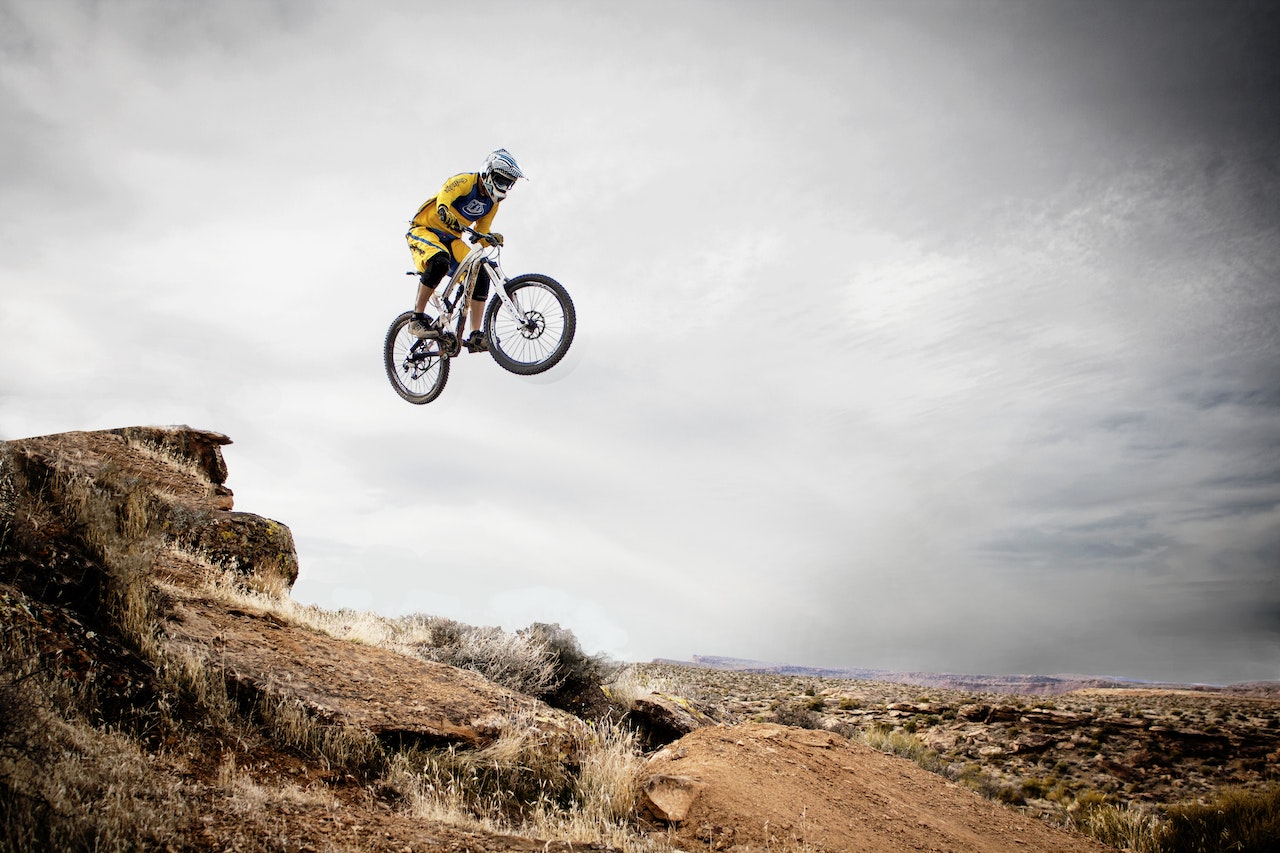Mountain biking is an exciting sport that combines adrenaline and adventure with demanding physical exertion. Experienced mountain bikers have the opportunity to participate in a variety of races, from short-distance sprints to hard-core multi-day endurance events. This article provides an overview of the different types of mountain bike races, from the more common downhill and cross-country events to the lesser-known adventure races and dual slalom competitions. Learn about these thrilling races and the skills needed to participate in them.
Mountain Bike Racing Disciplines
Cross-country mountain bike racing is the most popular form of mountain bike racing. This discipline involves the rider competing for the best time on a single lap of a set course. Many races involve several trails and require riders to negotiate steep hills, tricky terrain, and even jump obstacles. Cross-country mountain bike racing is the most spectator-friendly discipline because it often occurs on public trails or other well-known mountain bike locations.
Enduro Mountain Bike Racing
Enduro mountain bike racing is a relatively new form of racing that has emerged in the past few years. This discipline combines the technical aspects of downhill racing with the endurance elements of cross-country racing. This type of race typically involves the rider completing several stages of downhill racing over a long distance. Stages are generally un-timed but accumulate to determine the overall winner.
Downhill Mountain Bike Racing
Downhill mountain bike racing is a very specialized type of mountain bike racing. In this discipline, riders compete to set the fastest time going down a course that is usually much more technical than a cross-country course. Downhill courses are designed to challenge riders with jumps, drops, rock gardens, and other complex features. Many downhill courses also involve long descents with steep grades, making it a physically demanding form of racing.
Slopestyle Mountain Bike Racing
Slopestyle mountain bike racing is a newer discipline that has become popular in mountain bike racing. This competition involves the rider performing a series of tricks and stunts on a predefined course. The jokes are usually conducted over jumps, drops, berms, and other intimidating features. Slopestyle courses are typically much larger and more challenging than traditional cross-country courses, making them a physically demanding type of racing.
Dual Slalom Mountain Bike Racing
Dual slalom mountain bike racing is another specialized form of mountain bike racing. This type of racing involves two riders racing side-by-side down two different courses. The courses usually contain many jumps and tight turns, and the rider with the fastest time wins. Dual slalom racing is a great way to experience the thrill of mountain bike racing in a much more spectator-friendly environment.
Ultra-Distance Mountain Bike Racing
Ultra-distance mountain bike racing is a relatively new form of racing that challenges endurance athletes to compete over long distances. This type of race is typically on a single-loop course that covers anywhere from 50-200 miles and often includes challenging terrain, long and steep climbs, and complex conditions. Ultra-distance mountain bike racing is one of the most challenging forms of mountain biking, as riders are expected to race for hours on end without rest.
Cross Country (XC) Racing
Cross Country (XC) mountain bike racing is the most popular type of bike race and involves riding on a variety of terrain, on and off the road, for an extended period. XC races are typically shorter than the more endurance-based Marathon races, with most XC races lasting anywhere from 1 to 4 hours. The XC race courses may have some very technical sections. Still, they are primarily off-road trails with a mix of singletrack, short uphill or downhill sections, and, occasionally, some paved terrain.
XC Bike Equipment
For XC racing, riders typically use a full-suspension bike with a minimum of 100mm of travel. Hardtails, with no rear-wheel suspension, are also used for XC racing and can provide an advantage in some types of terrain. The bike should be light enough to allow the rider to remain agile yet strong enough to handle the challenging terrain in an XC race.
XC Race Tactics
Cross-country racing is all about efficiency. It is essential to anticipate upcoming terrain, select the correct gear and find ways to save energy while racing. In XC racing, it is possible to make time by being efficient in the corners and on climbs while utilizing the downhills to make up time. Additionally, many XC races require riders to carry with them some essential items such as food, water, tools, and spare tubes. Bringing these items can affect the bike’s weight, so finding a good balance between carrying the required items and having a light bike is crucial.
XC Racing Terminology
Cross Country (XC) racing has its terminology, and some of the most common terms include racing line, drafting, power-pedaling, and enduro. A racing line refers to the fastest line to take on a course, considering the trail’s terrain, obstacles, and direction. Drafting is when two or more riders ride close together to reduce the effect of wind resistance and help each other move faster. Power-pedaling is when the rider uses the full strength of their legs to maintain a steady pace up a climb. Enduro is a form of XC racing that emphasizes the downhills and technical sections while incorporating some uphill sections.
XC Race Training
Training for XC mountain bike racing involves building strength and endurance in both the upper and lower body and increasing the rider’s overall riding skill and technical ability. Training with various terrain and conditions is also essential, as XC races can be very different. To help prepare for an XC race, riders should practice the necessary technical skills, such as cornering, climbing, descending, and navigating obstacles. Additionally, it is beneficial to build aerobic endurance by doing long-distance rides and interval training.
Enduro Racing
Mountain biking has become one of the most popular sports and forms of recreation worldwide. As with any sport, riders can participate in different types of mountain bike races and competitions. This article will provide an overview of mountain bike races, including Enduro Racing, Cross-Country (XC), Downhill (DH), and Slopestyle.
Cross-Country (XC) Events
Cross-Country (XC) events are among the most popular mountain bike races. These races focus on endurance, technical skill, and speed. Competitors ride a course with significant climbs and descents, often on trails with obstacles and natural terrain. As the name implies, cross-country races can be held on paved and dirt tracks. The winner of the race is the rider who completes the course in the fastest time.
Downhill (DH) Races
Downhill (DH) races are the most popular form of gravity mountain biking. These races usually take place on downhill or singletrack trails and focus on speed, aggression, and technical skill. Riders will typically race two at a time, competing for the quickest time to the finish line. The fastest rider of the two is declared the winner of the race.
Slopestyle Mountain Bike Races
Slopestyle mountain bike racing combines elements of freestyle and downhill biking. Riders start from the top of a slopestyle ramp and attempt to perform aerial stunts and tricks. The riders are judged on the difficulty of their antics and the quality of their landings. The winner of the race is the rider who can gracefully complete the most difficult tricks.
Enduro Racing
Enduro Racing is an off-road mountain bike racing discipline focusing on endurance and technical skill. Enduro races are typically held over a multi-day period to complete multiple stages within a given time limit. Riders will race against the clock, with the fastest rider being declared the winner. Enduro races are typically held on singletrack trails with varying terrain and obstacles. Riders must manage their energy and pace throughout the race to complete it in the fastest possible time.
Downhill (DH) Racing
Downhill (DH) Racing is an exciting and adrenaline-filled form of mountain bike racing. This type of race involves riders pedaling downhill as fast as they can over a technical course, with jumps, berms, and other obstacles along the way. It tests both the rider’s technical skills and physical abilities. Racers must be prepared to endure a steep and rough course with sharp turns and uneven terrain – often with a higher risk of crashing due to the high speed.
Riders must be able to keep their composure and be comfortable navigating rough terrain, staying in control at all times. Racers must be able to make tight turns and accelerate quickly out of them, as well as maintain good balance throughout the course.
Safety Equipment for Downhill (DH) Racing
Riders should use the appropriate safety equipment to protect racers from potential crashes during downhill racing. This may include a full-face helmet, gloves, and knee and shin pads. Racers should also wear a backpack or hydration pack with supplies like spare bike parts and tools, a first-aid kit, and hydration.
Tips for Success in Downhill (DH) Racing
To be successful in downhill racing, it is vital to have confidence and to stay focused. Before each run, review the course with a mental focus, imagining yourself riding the trail as well as possible. Stay relaxed, trust your instincts, and concentrate on navigating the terrain during the run.
It is also essential to practice often and focus on improving technique, gaining speed, and building endurance. Improve bike handling capabilities, practice your starts and pedal strokes, and work on the cornering process.
Competitions for Downhill (DH) Racing
Downhill races usually consist of multiple timed runs. The competition may be as simple as one rider racing alone on the course at a time or several riders racing against each other. The rider with the quickest total cumulative time usually wins the competition.
Downhill races may also include events such as the Dual Slalom, where two riders race down two side-by-side tracks simultaneously. The first rider to reach the bottom of the course wins. Other events may include Super-G, where timed runs are completed down a single course, or 4X racing, where four riders race against each other on a single track.
Participating in Downhill (DH) Racing
Participation in downhill racing requires a certain level of skill and confidence, but with practice and dedication, anyone can become a successful racer. Many local mountain bike clubs and national mountain bike associations have opportunities to compete in races, and several websites provide information on upcoming races and competitions.
Short Track Cross Country (STXC) Racing
Short Track Cross Country (STXC) racing is one of the most exciting forms of mountain biking. This type of race is highly technical and relies on the rider’s agility, skill, and agility. STXC races are short, typically only one to three laps around a short, closed course, and require riders to navigate tight corners, hills, jumps, and other obstacles. STXC races are typically open to all levels of riders, and riders compete for prizes, recognition, and bragging rights.
The Benefits of STXC Racing
The short duration and intensity of STXC races make them an excellent choice for mountain bikers who want to enhance their skills and performance and those who are just starting. It is also an effective way for experienced riders to increase their speed and agility. For these reasons, STXC racing has become one of the most famous mountain biking events.
Competing in STXC Events
Competing in STXC events is a great way to hone your skills and test yourself against other riders. Riders must register in advance and prepare their bike and equipment to get started. Riders should familiarize themselves with the course before the race and bring ample hydration, energy snacks, and an emergency kit.
The Rules of STXC Racing
STXC races are governed by a set of rules and regulations enforced by the event coordinator. Riders must abide by these rules to avoid disqualification and to remain eligible for prizes. The most common practices involve the timing and positioning of riders on the course and adherence to closing times.
Unique Format of STXC Racing
The unique format of STXC racing allows riders to compete for a chance at winning with every lap. This encourages riders to push their limits and take risks while providing a safe way to experience the thrill of mountain biking competitions.
Adrenaline-Pumped STXC Races
With its tight corners, jumps, and challenging terrain, STXC races provide an exquisite adrenaline rush to riders of all levels. With the right combination of technique and determination, riders can achieve podium results and win recognition and awards.
Marathon Racing
Mountain bike marathon races are a type of race held on mountain biking trails. Unlike other mountain bike races, these races often have many participants and cover long distances with the goal of the race to complete the course in the shortest amount of time. These races usually feature large cash prizes, making them highly competitive and popular among mountain bikers.
Training Methods
Those participating in mountain bike marathon races must prepare for the long-distance race by training for months ahead of the race. This is done to ensure that the rider is in the good physical condition and can safely make it through the long course. Training for a marathon race typically involves long cycling distances, increasing the route length each time to get used to the long distances the race will require. Also, training for the race includes varying terrain, riding hills, and flat land to prepare for the different landscapes found on mountain bike marathon courses.
Common Equipment Required
Mountain bike marathon riders must also ensure they have the right equipment to race. It is essential to have a reliable mountain bike that is comfortable and has the right components to handle the terrain of the race. This can include suspension, tires, wheels, and other parts. Riders should also have spare parts if any components break during the race. Additionally, mountain bike marathon riders should have water bottles and food to keep them hydrated and energized throughout the race.
Race Day Strategies
On race day, the best strategy is to stay focused and maintain a good pace. Although a mountain bike marathon race may be long, it is essential not to go out too quickly and conserve energy for the later stages of the race when fatigue and exhaustion start to set in. Riders should also stay hydrated, rest when needed, and refuel. Additionally, it is important to pay attention to the course, as there are often obstacles and tight turns that riders need to be aware of.
Benefits of Participating
Mountain bike marathon races can be a great way to challenge yourself and become a better rider. These races push riders to their limits and require dedication and hard work to reach the finish line. Participating in them can also be an exhilarating experience, as riders will get to explore different terrains and experience the thrill of pushing themselves to their physical limits. Additionally, these races can be a great way to meet other mountain bikers and make lasting memories.
Ultra-Endurance Racing
Ultra-endurance racing is one of the most extreme forms of mountain bike racing. It involves races of exceptionally long distances, which typically last for several days. These events often include individual time trials, team time trials, and stage races which cover several different terrains. Ultra-endurance races can span many miles for days, weeks, or even months and involve multiple stages.
The Physiological Challenge of Ultra-Endurance Events
Racing ultra-endurance events require physical and mental strength and exceptional cycling skills. Endurance athletes must endure extreme physical and mental exhaustion throughout the event. This event also tests the rider’s ability to react to unexpected obstacles and cope with the demands of a long race.
The Equipment Needed for Ultra-Endurance Racing
Ultra-endurance events require specialized equipment. The rider will need a lightweight and reliable mountain bike and appropriate clothing and gear. The bike must withstand the rigors of long rides and extreme terrain. Depending on the race distance, a riding companion may also be required.
Navigation for Ultra-Endurance Events
Navigating ultra-endurance races is a complex task that requires a great deal of preparation. Riders must be trained in navigation, as well as be familiar with the route and terrain. GPS devices are becoming increasingly popular for navigation, allowing riders to track their location and progress accurately. Riders should also be equipped with a first aid kit and extra food and water in an emergency.
The Mental Challenge of Ultra-Endurance Events
Ultra-endurance events present a unique mental challenge to riders. The mental challenge of a long race is often grueling and can be even more challenging than the physical demands. Riders must stay motivated and focused on the goal of the race to push on and finish successfully. Mental preparation and control can differentiate success and failure in an ultra-endurance event.
Cyclo-Cross Racing
Mountain bike cross-country racing is one of the most famous mountain bike races. Cross-country mountain bike racing is an aerobic event that involves riding a mountain bike over rough terrain, including roots, rocks, and steep climbs. Riders must navigate this complex terrain without stopping and complete a certain distance within a specific time frame. Cross-country mountain bike racing is a great way to get an intense workout in an outdoor setting.
Enduro Mountain Bike Racing
Enduro mountain bike racing is another popular type of mountain bike race. Enduro racing combines timed downhill sections with uphill transfers in between. The timed downhill sections are designed to test a rider’s technical downhill skills, while the uphill transfers are designed to test the rider’s overall fitness. Enduro mountain bike races can range from two to multiple days, with a different course and terrain each day.
Cyclo-Cross Mountain Bike Racing
Cyclo-cross mountain bike racing is an intense and fast-paced type of race held on a mix of terrain. The course is usually short, and riders must complete several laps to finish. Cyclo-cross mountain bike racing is typically held on a combination of landscapes, such as dirt trails, grassy fields, and asphalt. Riders must traverse the course while carrying their mountain bike, as it is not allowed to ride on certain sections of the course. Cyclocross racing is becoming increasingly popular both as a competitive event and as a recreational activity. The races are often held in winter when other outdoor activities are impossible. Cyclo-cross racing is a great way to stay fit and have fun during winter.
Four-Cross Racing
Mountain biking has become increasingly popular over the years, with more and more people taking to the trails and competing in various mountain bike races. One of the most extreme and thrilling forms of mountain bike racing is Four-Cross (4X) racing. 4X is an incredibly competitive, fast-paced downhill race with four riders competing head-to-head on a single course.
The 4X course is usually a combination of dirt, artificial obstacles, and jumps, known as ‘berms’ and ‘rollers.’ Riders must navigate the system as quickly as possible while fending off the competition to triumph. Races can become highly competitive, with riders getting creative to gain an advantage over their rivals.
Choosing the Right Gear for 4X Racing
To optimize performance in 4X racing, riders must choose the right gear. 4X bikes are typically full-suspension and can be single-speed or geared. The bikes should also have a low bottom bracket for stability and agility and a slack head angle for improved control. 4X bikes usually have a wide handlebar for enhanced strength and strong disc brakes for efficient and effective stopping power.
Mountain Bike Course Strategies for 4X Racing
Aside from choosing the right gear for 4X racing, riders must also develop tactics to gain an edge. Being well-prepared is critical, so riders should practice routes before competing and familiarize themselves with the points of the course. Riders should also consider their opponents’ strengths and weaknesses and plan accordingly.
Training for 4X Mountain Bike Racing
To prepare for 4X mountain bike racing, riders must undertake a training regimen that reflects the demands of the sport. Cross-training is essential, with riders advised to incorporate strength and cardio exercises into a consistent workout routine. Core strength is significant, as it enables riders to maintain their position while riding down the course.
Mountain biking is thrilling and adrenaline-filled, and 4X mountain bike racing is perhaps the most extreme version of the sport. By selecting the right gear, developing a course strategy, and undertaking an appropriate training regime, riders can optimize their performance and get the most out of the competition.
Dual Slalom Racing
Dual slalom racing is an exciting and challenging form of mountain bike racing. It is a type of gravity-assisted racing in which two competitors race side-by-side down a course, competing against each other in a head-to-head format. The course consists of two side-by-side tracks, with the riders alternating between tracks to gain the advantage.
Dual slalom races are held on courses with tight turns and challenging obstacles, such as jumps and berms. The courses are often set up with varying difficulty levels, making for an exciting and unpredictable race. Riders must use their technical skills to navigate the trail quickly and safely.
Equipment For Dual Slalom Racing
Dual slalom racing requires specialized mountain bikes, with a short travel suspension system, for maximum speed and control. Helmets and other safety gear, such as elbow and kneepads, are also required. Riders will often use a one-piece riding suit designed to reduce drag and provide aerodynamic benefits.
Dual Slalom Racing Competitions
Dual slalom racing competitions are held at many more significant mountain bike events, such as the Crankworx World Tour. They are also a popular event at amateur and local mountain bike races. Dual slalom racing is a fun and exciting way to test your technical skills and compete with other riders.
The Racing Format
Dual slalom races are short and fast, typically lasting around two minutes. The two competitors race on side-by-side tracks, with the riders alternating between the tracks to gain an advantage. The first rider to cross the finish line is the winner.
Dual slalom racing is an exciting and thrilling form of mountain bike racing. Riders must use their technical skills and agility to navigate the course as quickly and safely as possible. It is a great way to challenge yourself and compete with other riders.
Mountain Biking a Popular Sport
Mountain biking has become an increasingly popular sport for recreational and competitive riders, with various race types for everyone. Cross-country racing is a typical starting point for mountain bike racers, as it tests endurance and technical skills. Downhill competitions are all about speed and are a thrilling experience for riders and spectators alike. Endurance events combine cross-country and downhill racing, where racers must have good technical skills and solid endurance. National points series competitions can be an excellent way for racers to get involved in the sport at a higher level. Finally, with the growing popularity of and innovations in mountain biking, more unique events such as slalom, dirt jumping, pump track, and BMX racing have been popping up in recent years.
Mountain biking is a fun, challenging, and exciting sport that continues to grow and evolve, providing options for all riders. Whether you are an avid racer or casual rider, there’s a mountain bike race for everyone to enjoy.






Leave a reply